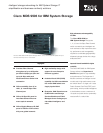
bandwidth, providing up to 16 Gbps
throughput per port (full-duplex). This
module is best suited for connection to
4 and 8 Gbps high-performance stor-
age devices and for Inter Switch Link
(ISL) connectivity.
The 48-port 8 Gbps Fibre Channel
Switching Module is designed to
deliver an ideal balance of performance
and scalability. Its 48 autosensing
1, 2, 4 and 8 Gbps ports deliver up to
96 Gbps of full-duplex bandwidth to
meet the performance demands of
enterprise-class or highly virtualized
servers. Through easy-to-use traffic
engineering capabilities, the 48-port
8 Gbps Fibre Channel Switching
Module offers the flexibility to provide
predictable high-performance storage
and inter-switch connectivity, fully utiliz-
ing the available bandwidth.
The 4/44-port 8 Gbps Host-
Optimized Fibre Channel Switching
Module is optimized for host connec-
tivity. The module enables storage net-
work consolidation with high-density,
cost-effective connectivity. Four 8 Gbps
ports and forty-four 4 Gbps ports
deliver 96 Gbps of full-duplex band-
width, sufficient for the majority of
today’s standard servers.
4-port 10 Gbps switching module:
Configuring the switch for metro business
continuity
The 4-port 10 Gbps Fibre Channel
Switching Module is designed to
deliver high bandwidth links for metro
business continuity solutions. The mod-
ule uses hot-swappable X2 form-factor
pluggable, SC type transceivers. The
module is well suited for ISL links
between data centers across metro
optical networks.
Port Bandwidth Reservation, available
on all switching modules, enables
switching bandwidth to be dedicated to
specific ports. This unique feature of
the Cisco MDS 9000 family enables
great flexibility in bandwidth allocation
to support a mix of applications
within a single module, including high-
performance ISLs. By combining vari-
ous switching modules in a single
modular chassis, it is possible to design
storage networks optimized for cost
and performance in a wide range of
application environments. This applica-
tion-oriented approach to port deploy-
ment can reduce the number of
switches and ISLs required in a storage
network, in many cases eliminating the
need for core-edge network topologies.
A switch designed for high availability
The Cisco MDS 9506 for IBM System
Storage combines support for non-
disruptive software upgrades, stateful
process restart/failover and redundancy
of active hardware components to sup-
port director-class availability. The
Supervisor-2 Module has the ability to
automatically restart failed processes
and complete synchronization between
the active and standby Supervisor
Modules to help support stateful failover
without disruption to traffic.
A switch designed for virtual servers and
applications
Server virtualization means that a SAN
must concurrently support thousands of
diverse, tiered applications, each with
unique performance requirements.
These applications and the virtual
machines (VMs) they run on are not
bounded by physical servers and net-
work ports. The Cisco MDS 9000
Family provides deterministic hardware
performance and a rich feature set that
allows VMs to have the same SAN
attributes as a physical server. On a
per-VM basis, the MDS 9000 Family
NX-OS firmware offers Virtual SAN
(VSAN) isolation, Quality of Service
(QoS) policies, access control, perform-
ance monitoring, and data protection to
enable scalability and mobility of VMs.










